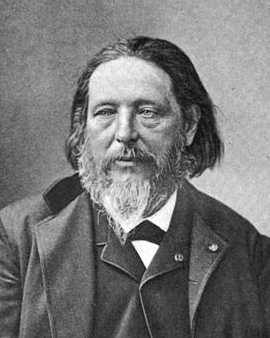The works of the French realism painter Jules Breton (1827 - 1906) are strongly influenced by the French landscape, love of tradition and simple rural life. For Breton himself was born in a small village in Pas-de-Calais. He lived in a house with his father, his grandmother, his younger brother Émile and his uncle Boniface. Since his mother died when Breton was four years old, his father was mainly responsible for his upbringing. Initially Breton studied at a college near his home town. When he met the Belgian painter Félix De Vigne in 1842, he was enthusiastic about the talent of the young Breton. De Vigne convinced the family to let him study art. The following year Breton went to Ghent and began his training at the Academy of Fine Arts. There he was taught by Hendrik Van Der Haert and De Vigne, who would later become his father-in-law.
After his training in Ghent and the study of Flemish masters at Gustaaf Wappers in Antwerp, Breton moved to Paris in 1847. There he wanted to develop his technique and style at the Ecole des Beaux-Arts. In Paris he met and became friends with some other important painters of Realism such as François Bonvin and Gustave Brion. In his early years in Paris, Breton still tried his hand at historical and later political motifs, influenced by the revolution of 1848, but Breton found that he was ultimately more attracted to the landscape motifs he knew from his homeland. Thus, his most important works include motifs such as "The Return of the Honorary Readers", "Girl Sieving Rape" or "The Blessing of the Fields".
Breton was a contemporary of Vincent van Gogh. But unlike Van Gogh, who lived poorly during his lifetime, Breton was very successful during his lifetime. He was able to sell many of his works directly to museums, art dealers or collectors. Therefore he could afford to work on a work for several months. Van Gogh is said to have admired Breton, but did not dare to visit him. Breton died at the age of 79. His daughter Virginie Demont-Breton also became a painter and was one of his students.
×





.jpg)
.jpg)
.jpg)
.jpg)
.jpg)
.jpg)
.jpg)
.jpg)
.jpg)
.jpg)
.jpg)
.jpg)
.jpg)
.jpg)
_-_(MeisterDrucke-1528605).jpg)
_-_(MeisterDrucke-1528605).jpg)
.jpg)
.jpg)
.jpg)
.jpg)
_1859_Sun_09x176_m_P_-_(MeisterDrucke-951238).jpg)
_1859_Sun_09x176_m_P_-_(MeisterDrucke-951238).jpg)
.jpg)
.jpg)
.jpg)
.jpg)
.jpg)
.jpg)
.jpg)
.jpg)
.jpg)
.jpg)
.jpg)
.jpg)
.jpg)
.jpg)
.jpg)
.jpg)
.jpg)
.jpg)
.jpg)
.jpg)
.jpg)
.jpg)
.jpg)
.jpg)
.jpg)
.jpg)
.jpg)
.jpg)
_-_(MeisterDrucke-1227334).jpg)
_-_(MeisterDrucke-1227334).jpg)
.jpg)
.jpg)
.jpg)
.jpg)
.jpg)
.jpg)
_(oil_on_cardboa_-_(MeisterDrucke-1027955).jpg)
_(oil_on_cardboa_-_(MeisterDrucke-1027955).jpg)
.jpg)
.jpg)
.jpg)
.jpg)
.jpg)
.jpg)
.jpg)
.jpg)
.jpg)
.jpg)
.jpg)
.jpg)
.jpg)
.jpg)
.jpg)
.jpg)
.jpg)
.jpg)
.jpg)
.jpg)
_1859_Sun_1_-_(MeisterDrucke-1002183).jpg)
_1859_Sun_1_-_(MeisterDrucke-1002183).jpg)
.jpg)
.jpg)
 1860 - (MeisterDrucke-143429).jpg)
 1860 - (MeisterDrucke-143429).jpg)
.jpg)
.jpg)
.jpg)
.jpg)
.jpg)
.jpg)
_-_(MeisterDrucke-1517994).jpg)
_-_(MeisterDrucke-1517994).jpg)
.jpg)
.jpg)
.jpg)
.jpg)
.jpg)
.jpg)
.jpg)
.jpg)
.jpg)
.jpg)
.jpg)
.jpg)
.jpg)
.jpg)
.jpg)
.jpg)
.jpg)
.jpg)
.jpg)
.jpg)
.jpg)
.jpg)
.jpg)
.jpg)
.jpg)
.jpg)
.jpg)
.jpg)
.jpg)
.jpg)
.jpg)
.jpg)
.jpg)
.jpg)
.jpg)
.jpg)
.jpg)
.jpg)
.jpg)
.jpg)
.jpg)
.jpg)
.jpg)
.jpg)
.jpg)
.jpg)
.jpg)
.jpg)
.jpg)
.jpg)
.jpg)
.jpg)
.jpg)
.jpg)
.jpg)
.jpg)
.jpg)
.jpg)
.jpg)
.jpg)
.jpg)
.jpg)
.jpg)
.jpg)






